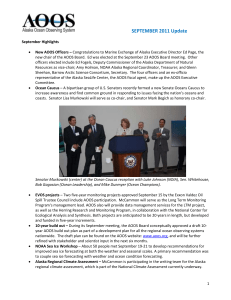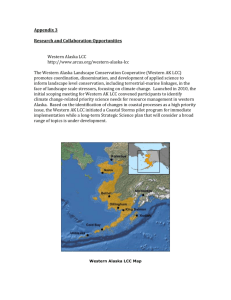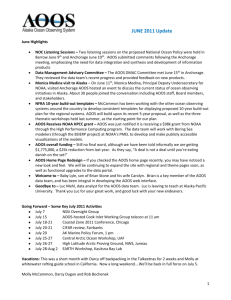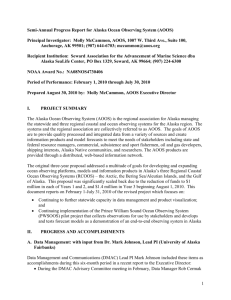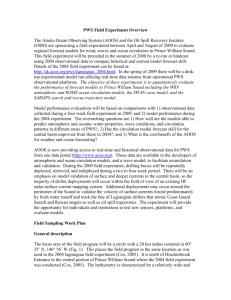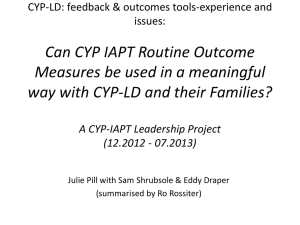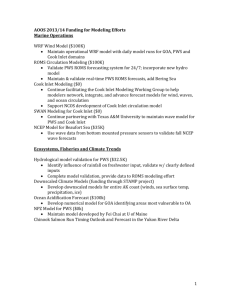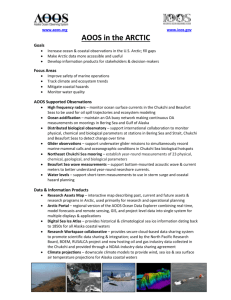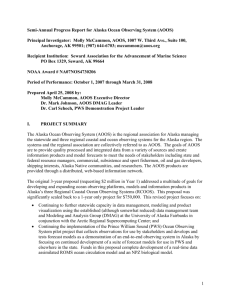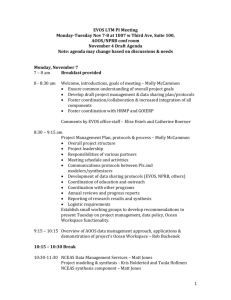Molly McCammon, AOOS Executive Director
advertisement
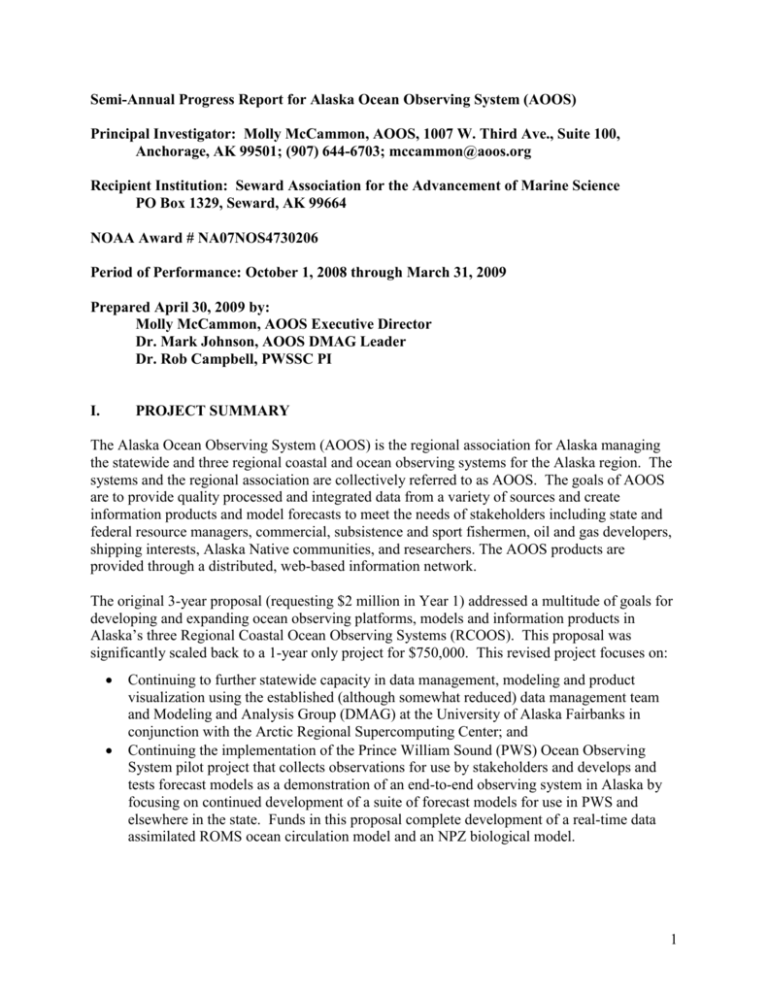
Semi-Annual Progress Report for Alaska Ocean Observing System (AOOS) Principal Investigator: Molly McCammon, AOOS, 1007 W. Third Ave., Suite 100, Anchorage, AK 99501; (907) 644-6703; mccammon@aoos.org Recipient Institution: Seward Association for the Advancement of Marine Science PO Box 1329, Seward, AK 99664 NOAA Award # NA07NOS4730206 Period of Performance: October 1, 2008 through March 31, 2009 Prepared April 30, 2009 by: Molly McCammon, AOOS Executive Director Dr. Mark Johnson, AOOS DMAG Leader Dr. Rob Campbell, PWSSC PI I. PROJECT SUMMARY The Alaska Ocean Observing System (AOOS) is the regional association for Alaska managing the statewide and three regional coastal and ocean observing systems for the Alaska region. The systems and the regional association are collectively referred to as AOOS. The goals of AOOS are to provide quality processed and integrated data from a variety of sources and create information products and model forecasts to meet the needs of stakeholders including state and federal resource managers, commercial, subsistence and sport fishermen, oil and gas developers, shipping interests, Alaska Native communities, and researchers. The AOOS products are provided through a distributed, web-based information network. The original 3-year proposal (requesting $2 million in Year 1) addressed a multitude of goals for developing and expanding ocean observing platforms, models and information products in Alaska’s three Regional Coastal Ocean Observing Systems (RCOOS). This proposal was significantly scaled back to a 1-year only project for $750,000. This revised project focuses on: Continuing to further statewide capacity in data management, modeling and product visualization using the established (although somewhat reduced) data management team and Modeling and Analysis Group (DMAG) at the University of Alaska Fairbanks in conjunction with the Arctic Regional Supercomputing Center; and Continuing the implementation of the Prince William Sound (PWS) Ocean Observing System pilot project that collects observations for use by stakeholders and develops and tests forecast models as a demonstration of an end-to-end observing system in Alaska by focusing on continued development of a suite of forecast models for use in PWS and elsewhere in the state. Funds in this proposal complete development of a real-time data assimilated ROMS ocean circulation model and an NPZ biological model. 1 II. PROGRESS AND ACCOMPLISHMENTS A. Data Management and Analysis Group: Dr. Mark Johnson, Lead PI, University of Alaska Fairbanks The Data Management and Analysis Group develops data management and communications products, data visualization tools, and satellite remote sensing products. Data Management and Communications (DMAC) The AOOS Data Manager Rob Cermak serves on the national DMAC committee and has a key role in writing DMAC planning documents. Significant real-time data is now on line and available to stakeholders, along with the popular web-cams from a number of statewide locations. DMAC is collaborating with the Coast Guard Search and Rescue, the North Pacific Research Board, Minerals Management Service, Barrow Arctic Science Consortium and others to provide data to state and federal agencies. AOOS is developing the Alaska Marine Information System, a project and metadata browser that provides an easy to use web-interface for Alaskan projects and datasets. To meet national standards, the project and metadata browser will search the AOOS data records to automatically update the status of our data holdings. Experience gained through this will apply to the development of the broader metadata browser necessary for allowing stakeholders to search for specific data. New data streams acquired by AOOS will meet IOOS metadata standards, however, at present we acquire as much data as possible with the hope that future funding will allow a dedicated data handler to work with data providers to create relevant metadata. The initial version of the Alaska Marine Information System (AMIS) will soon be released to our stakeholders; a public demonstration was conducted at the Alaska Marine Science Symposium in Anchorage, Alaska in late January 2009. This symposium has become ‘the’ event for the marine science community in Alaska, and we expect that AMIS will meet numerous needs of our broad stakeholder base. To meet their needs, the above project browser is searchable by a suite of variables including the PI name, dataset title, start and end dates, funding organization, keywords, IOOS core variables, study area, science platform or sensor, and similar variables. Each project has a geographical study area so the user can see on a map where projects are located and how different project areas may overlap. Data Visualization and Information Product Development AOOS is part of the IOOS working group that is implementing the IOOS data backbone. One of our primary efforts is making the SOS service available so that all RAs will deliver the same data sets as NDBC, COOPS, etc. Similarly, we are incorporating WFS and WMS protocols as well in order to move files and map them. We are using the Prince William Sound Field Experiment slated for summer 2009 as a demonstration to get data to the IOOS backbone. Example data streams include SNOTEL, ADCP, and CTD data plus data streams from national assets such as C-Man stations, NDBC buoys, and HADS. Presently, AOOS acts as “local knowledge” to ensure that these data streams meet the national IOOS standards in data format. We are meeting the needs of a suite of additional stakeholders. Minerals Management Service (MMS) receives real-time surface data feeds from the AOOS DMAC that currently collects all 2 available real-time data in Alaska, including the interior portions of the state. Data from these nonmarine sections of the state are important, particularly interior temperatures, because broad coverage of atmospheric parameters is necessary for model development and validation. AOOS DMAC has acquired additional funding from the North Pacific Research Board (NPRB) to provide the data management services for the Bering Sea Integrated Ecosystem Research Program (BSIERP). The above services as well as other requests that come in from across the state underscore the importance of the service that AOOS DMAC provides to the science and stakeholder communities. B. Prince William Sound Demonstration Project: Dr. Rob Campbell, Prince William Sound Science Center Lead PI The PWS pilot project is progressing as planned under the leadership of PWSSC Lead PI Dr. Rob Campbell and project lead PI Dr. Carl Schoch. Funds in this proposal are being used to complete 2 of the 4 major AOOS models: the ROMS model and the NPZ model. AOOS has partnered with, and supplemented investments for the past three years by the Prince William Sound (PWS) Oil Spill Recovery Institute, the PWS Science Center, and the PWS Regional Citizens’ Advisory Council, to demonstrate an end-to-end ocean observing system with a primary focus on forecasting surface currents (primarily for oil spill response), and a secondary goal of forecasting the timing and magnitude of spring plankton blooms for improved fishery and hatchery management. A major field experiment and evaluation will occur in 2009 to assess which observing system components are critical to the major stakeholder groups in PWS (e.g. coastal communities, oil and gas transportation industry and oil spill responders, commercial fishermen, recreational and commercial boaters, and Coast Guard search and rescue responders). The high resolution wind, wave and ocean current forecast products provide expanded and improved marine safety for recreational and commercial vessel operators and enhance the security to oil tanker traffic in PWS. Improved environmental and ecological forecasting products will enable resource managers, PWS hatchery and commercial fishing organizations to improve management decisions on fishing and human activities. The nested ROMS (Regional Ocean Modeling System) circulation and NPZ (Nutrient Phytoplankton Zooplankton) biological forecasts, the SWAN (Simulating Waves Nearshore) wave model, and the WRF (Weather Research and Forecasting) model have been developed and will be operational for the observing system experiment (OSE), which will be conducted July 19 to August 2, 2009. Deployment of an array of nearshore ocean sensors, as well as a high frequency radar array, will provide real-time boundary conditions for model assimilation, and vessel surveys will provide synoptic data for model validation. The OSE Scientific Steering Team met in January 2009 to plan the experiment, and to discuss education and outreach activities. Prince William Sound Ocean Modeling (Dr. Yi Chao, JPL) As part of the Prince William Sound Ocean Observing System (PWSOOS) we have been developing a real-time nowcast-forecast modeling system. The system consists of a regional 3 ocean model component forced by output from a regional atmospheric component. The ocean component is the Regional Ocean Modeling System (ROMS) and the atmospheric component is the WRF regional atmospheric model. When fully developed the system will assimilate realtime streams of data, gathered in-situ or remotely sensed, and produce routine predictions of ocean conditions for PWS and northern shelf of the Gulf of Alaska. The ROMS model consists of a 3-level nested configuration covering the Prince William Sound at 1-km resolution, the northeastern Gulf of Alaska (GOA) at 3-km, and the northeastern Pacific Ocean at 9-km; a similar nested ROMS configuration has been used successfully in the Monterey Bay region. We are currently developing a data assimilation system suitable for this PWS ROMS version. In this system, near real-time in situ and satellite data will be assimilated to provide operational nowcasts which serve as the initial conditions for 2-3 day forecasts (depending on the availability of forecast atmospheric fields). The ROMS assimilation model output will be made available to PWSOOS users through a web-based database and graphic interface as well as a Live Access Server (LAS). Coastal freshwater discharge and tides have been identified as primary driving mechanisms of the local coastal circulation in the Gulf of Alaska (GOA) and Prince William Sound (PWS). In order to incorporate freshwater discharge into the PWS ROMS, the digital elevation model (DEM) of Wang et. al (2004) is being used. The model is forced by air temperature and precipitation data from the regional atmospheric model (WRF), or from NCEP reanalysis data. The DEM also includes glacier, snow storage, and melting processes. The freshwater discharge has been divided into point sources (major rivers) and line sources (grid coastlines). We have applied this model in the three ROMS model domains in the North Pacific Ocean/GOA regions. We have validated the model by comparing the simulated runoff for the point source representing the Copper River to observed streamflow at this location, and are using these outputs to force the PWS ROMS model. We have developed and implemented a 3-dimensional variational data assimilation (3DVAR) scheme into the PWS ROMS configuration. We selected the 3DVAR data assimilation methodology because of its ability to propagate observational information, which is often sporadically and irregularly distributed, in both the horizontal and vertical directions through an advanced error covariance formulation, as well as its computational efficiency that enables realtime operational forecasting. Our ROMS 3DVAR is designed to assimilate all types of observations simultaneously and reliably. Different types of observations come with different errors and generally are dynamically inconsistent. One challenge is to keep the obtained analysis in reasonable dynamic balance after the different types of observations are assimilated. The ROMS 3DVAR currently incorporates particular weak constraints based on hydrostatic and geostrophic balance, though these two balance constraints can be replaced by more sophisticated balance equations. Concerning the data needed for assimilation, we have implemented a daily download and processing of the currently available real-time observational data, and are also downloading daily WRF atmospheric model 48-hour forecasts performed at the University of Alaska, Anchorage as part of AOOS/PWSOOS. During this period work has focused on completion of an evaluation of the performance of the ROMS 3DVAR scheme during summer 2004 and preparing a spin-up run for 2009 in 4 anticipation of this summer's field experiment. We have completed and analyzed a final (and best) run (which we refer to as a reanalysis) for the period 15 July – 15 August 2004. The primary datasets available for assimilation during this period are AVHRR sea surface sea temperatures, HF radar surface currents and a limited number of vertical profiles of temperature and salinity during late July/early August. Use of the assimilation scheme results in significant improvements in the temperature and salinity fields, though the near-surface improvements in salinity are marginal. We are especially interested examining the model's depiction of a persistent cyclonic eddy observed during this period and in comparing modeled surface currents for consistency with observed drifter trajectories. Figure 1 shows a snapshot of the ROMS reanalysis current vectors at 01 UTC, 8 August 2004 overlaid on a color image of the ROMS surface salinity field. The vectors clearly show the cyclonic eddy that dominates the circulation in the area north of the Hinchinbrook Entrance. Also shown in Figure 1 are the trajectories of two drifters released on August 4 within this eddy circulation. The cyclonic trace of both these trajectories reveals the persistent eddy circulation. Figure 2 shows the same type of image except using snapshot of the HF Radar surface currents, whose assimilation was instrumental in the success of the ROMS reanalysis in reproducing the eddy. As was demonstrated in previous work, the inclusion of tidal forcing is also an important element required to reproduce this cyclonic eddy. In anticipation of this summer's field experiment we have begun preparing in earnest for realtime operations. We have implemented the real-time downloading and processing of atmospheric forcing data. For the two outer domains (GOA and NE Pacific), we are using the NCEP Global Forecast System 0.5 degree data. For the innermost domain (PWS), we use the AEFF WRF 4km data. All operationally available datasets, such as ship, MODIS and AVHRR sea surface temperatures and a limited number of current profilers (ADCPs) are currently being downloaded and processed (in real-time) into a form suitable for assimilation. We are also performing a spin-up run of our Digital Elevation-based runoff model up for 2009 to produce accurate freshwater forcing for the ROMS spin-up run. We will very shortly begin this run, with a start time of late March 2009, expecting to 'catch-up' to real-time well in advance of the experiment in late July. Finally, we anticipate using a two-tier run strategy (see Figure 3) that we have recently implemented successfully in our Southern California Bight (SCB) operations. In this strategy, the first run cycle of the day is started within 6 hours (real-time) of the first analysis time. At this point, a large amount - but not all - of the data to be assimilated has normally been received. This cycle runs through 24 hours, finishing by executing a 48 hr forecast. It is designed to deliver good results as quickly as possible. The second run cycle, or re-run, begins as late in the day as possible given that it must complete before the run cycle for the next day begins. This cycle has available a more complete set of observational data and - possibly- updated atmospheric forcing. This re-run is designed to deliver the best results (nowcast and forecast results from the re-run overwrite those of the first run when they become available) and provide the best possible initial condition for the next day's run cycle. 5 Figure 1. The ROMS reanalysis sea surface salinity (in PSU, color image) overlaid with ROMS surface current vectors for 8 Aug 2004 and two observed drifters trajectories during the period 4 – 12 Aug 2004. 6 Figure 2. The ROMS reanalysis sea surface salinity (in PSU, color image) overlaid with observed HF radar surface current vectors for 8 Aug 2004 and two observed drifters trajectories during the period 4 – 12 Aug 2004. 7 Figure 3. A schematic of the real-time ROMS operations cycle to be used during the PWS experiment. NPZ: The ecosystem modeling for the Prince William Sound (Dr. Fei Chai, UM) As a part of the nowcast-forecast modeling effort, we have developed and incorporated a marine ecosystem model into the ROMS circulation model. The marine ecosystem processes are based on Carbon, Si(OH)4, and Nitrogen Ecosystem (CoSiNE) Model, which consists of multiple nutrients and plankton functional groups. In collaboration with Dr. Yi Chao’s group at the JPL/NASA, we have used a version of the PWS circulation model to implement the CoSiNE model, and conducted simulations to test model structure and parameters. The ROMS-CoSiNE has been forced with atmospheric modeled wind and heat flux for Gulf of Alaska and PWS region, starting January 1 to December 31, 2004, as a testing period. We have successfully coded the CoSiNE model into the PWS ROMS, and have been able to conduct several coupled model runs for 2004. The ecosystem model is able to reproduce seasonal cycles of phytoplankton growth dynamics, which depends on the light, nutrients, and temperature for the PWS. We have started to analyze the model results, and have diagnosed and fixed a few technical issues related to both circulation and ecosystem models. The first version of the circulation model for PWS did not incorporate rivers and tides, which created problems for nutrient transport: vertical mixing was underestimated, and the lack of freshwater inputs reduced 8 vertical stratification. These effects balanced each other, producing reasonable nutrient concentrations, but for the wrong reasons. We are in the process of implementing the CoSiNE into the new PWS ROMS 3DVAR code. In the next six months we intend to pursue the following ecosystem modeling activities: 1) continue to test the CoSiNE model with the latest ROMS code for the PWS, which include rivers and tides; 2) analyze the PWS ROMS-CoSiNE model results, and compare remote sensing observation with the model results; 3) conduct near real-time simulations and prepare for the field experiment during July-August 2009. Our long-term modeling goals are to establish coupled circulation-ecosystem models that are capable of producing real-time and forecasts of nutrients, plankton, and marine habitat for key fisheries for the PWS and northern shelf region of the Gulf of Alaska. III. ISSUES A. Funding uncertainty AOOS began operating in the summer of 2005 using a $2 million FY 2005 earmark. That earmark was reduced to $1.7 million in FY 2006. Following a competitive process, AOOS was awarded $750,000 in June 2007, and following another competitive process for FY 08 funds, an additional $1 million in summer 2008 and $1 million in summer 2009. This funding variability and uncertainty continue to make it very difficult to develop and sustain a program, hire and keep qualified personnel, and proceed forward with long-term plans. The reduction in 2007 required AOOS to drop its financial support for the Amukta Pass and Southeast mooring programs and the Barrow ice radar, reduce staffing for the DMAG group, and significantly pare down the goals for the Prince William Sound pilot project. These are significant losses to the AOOS stakeholders since they are in addition to the loss of the Bering Strait moorings and work in Cook Inlet/Kachemak Bay in 2006. With the recent record minimum Arctic ice in summer 2007 and minimum volume in summer 2008, there is a pressing need for improved monitoring and forecasting capability in Alaska—the U.S. Arctic—for marine navigation and safety and to continue to understand climate change. The additional funds in 2008 and 2009 will only allow for the core data management group to continue, and to fund the Prince William Sound demonstration project. We will continue our existing efforts to leverage the AOOS data system with other agency programs that might have future funding for observation components. B. Future of HF Radar Although funds are not included in this project for HF Radar, the use of this technology is critical for the future of AOOS in Alaska. The major issue regarding the use of HF radar as a tool in Alaska’s ocean observing program relates to the lack of electricity at remote sites and the need for a robust, cost-effective remote power source. Major funding is required to develop and maintain a team to work on HF radar year round. Apparently this is an issue of concern to other Regional Associations, and thus, might be appropriately addressed at the national level. C. Modeling needs The ocean circulation models being developed for Alaska waters depend on the boundary conditions identified through large-scale North Pacific models. The other Pacific Ocean 9 observing systems will rely on these large-scale North Pacific models, as will international efforts such as the Global Ocean Observing System (GOOS). IOOS needs to address the issue of what are national responsibilities for modeling, and what are regional responsibilities. Alaska’s largest challenge is with ecosystem based management and models to support these efforts. There is still significant uncertainty regarding this. A strategy should be developed to build a modeling component that will build on and share expertise at the local level and nationally. E. Expectation management Given the uncertainty of future funding, AOOS staff has had a difficult time “selling” the IOOS program, particularly to commercial fishermen and other industry sectors – potentially our largest customers and stakeholders. We need to develop a national strategy for this that can be used at the regional level. F. Transition from research to operations We are going to find it challenging in Alaska to transfer many of our observing system components into an operational system. Given our remote coastline, vast distances to ship and human support, and extreme weather conditions, our systems will need substantial time and funding to become truly operational. IV. KEY PERSONNEL The AOOS Data Management team hired a new web programmer in fall 2008. Dr. Rob Campbell is the lead PI for the Prince William Sound Science Center portion of the program. Dr. Carl Schoch continues to act as a consultant for the project and provide the overall leadership for the field experiment. V. BUDGET ANALYSIS Since budget expenditures were lagging somewhat behind the project proposal because of an attempt to use up all prior year funds, we requested and were granted a one year extension. Expenditures are now on track to complete this project on schedule. All financial reports are up to date. 10
